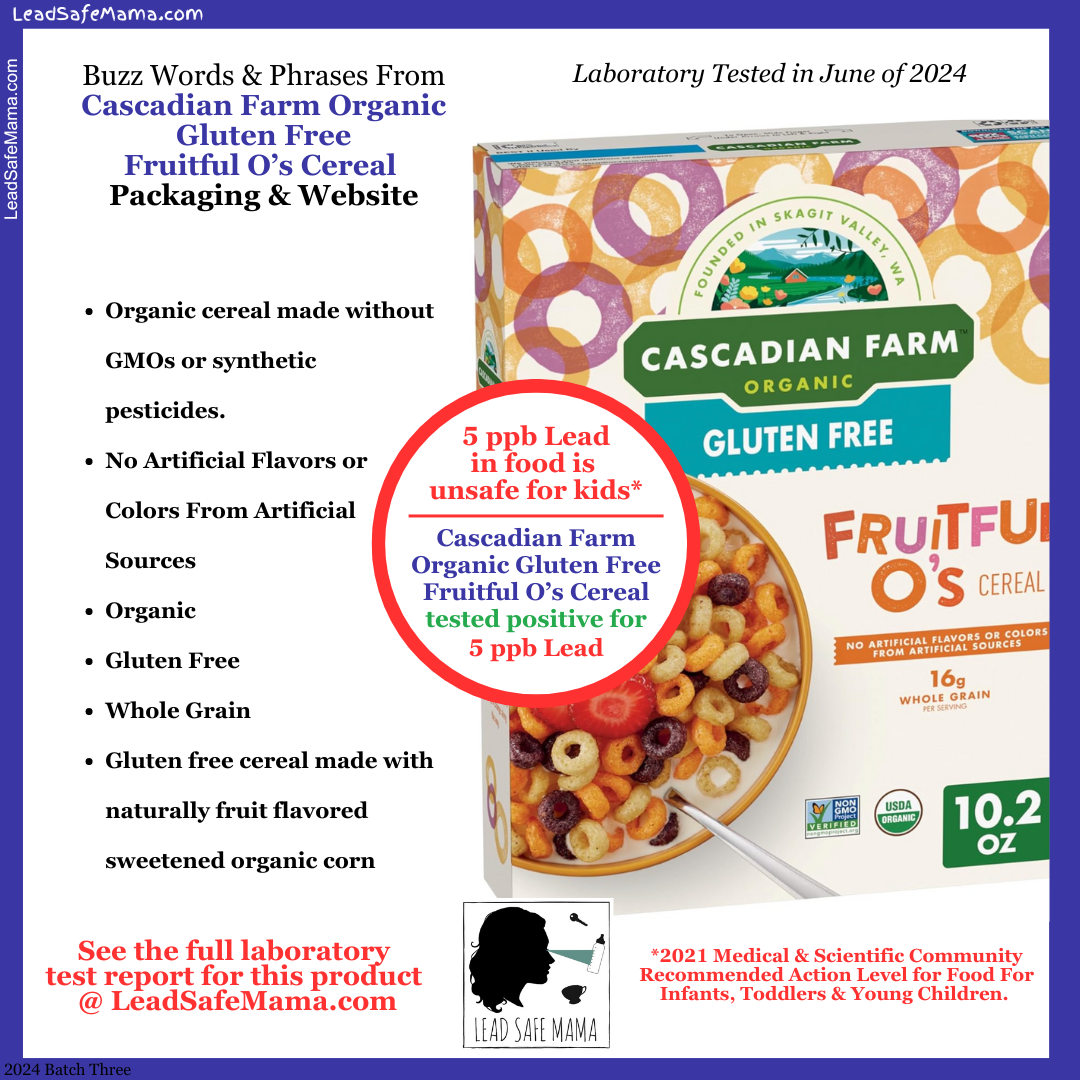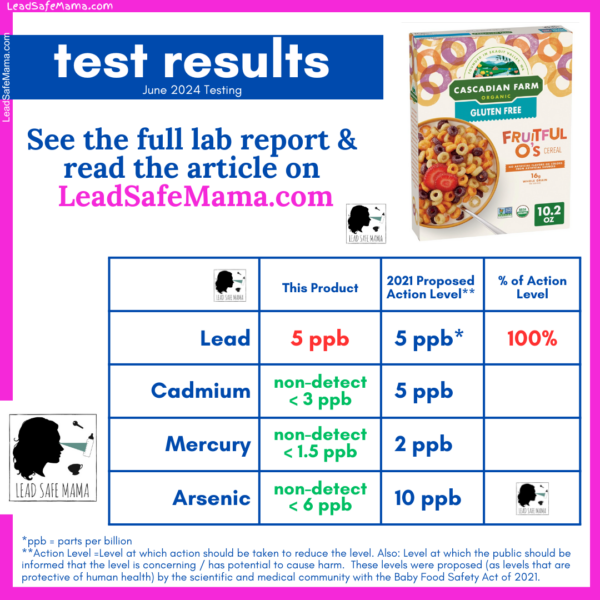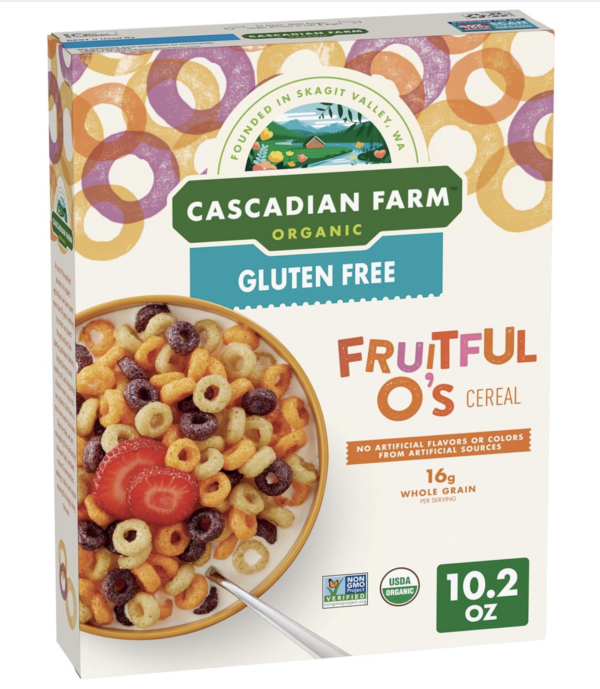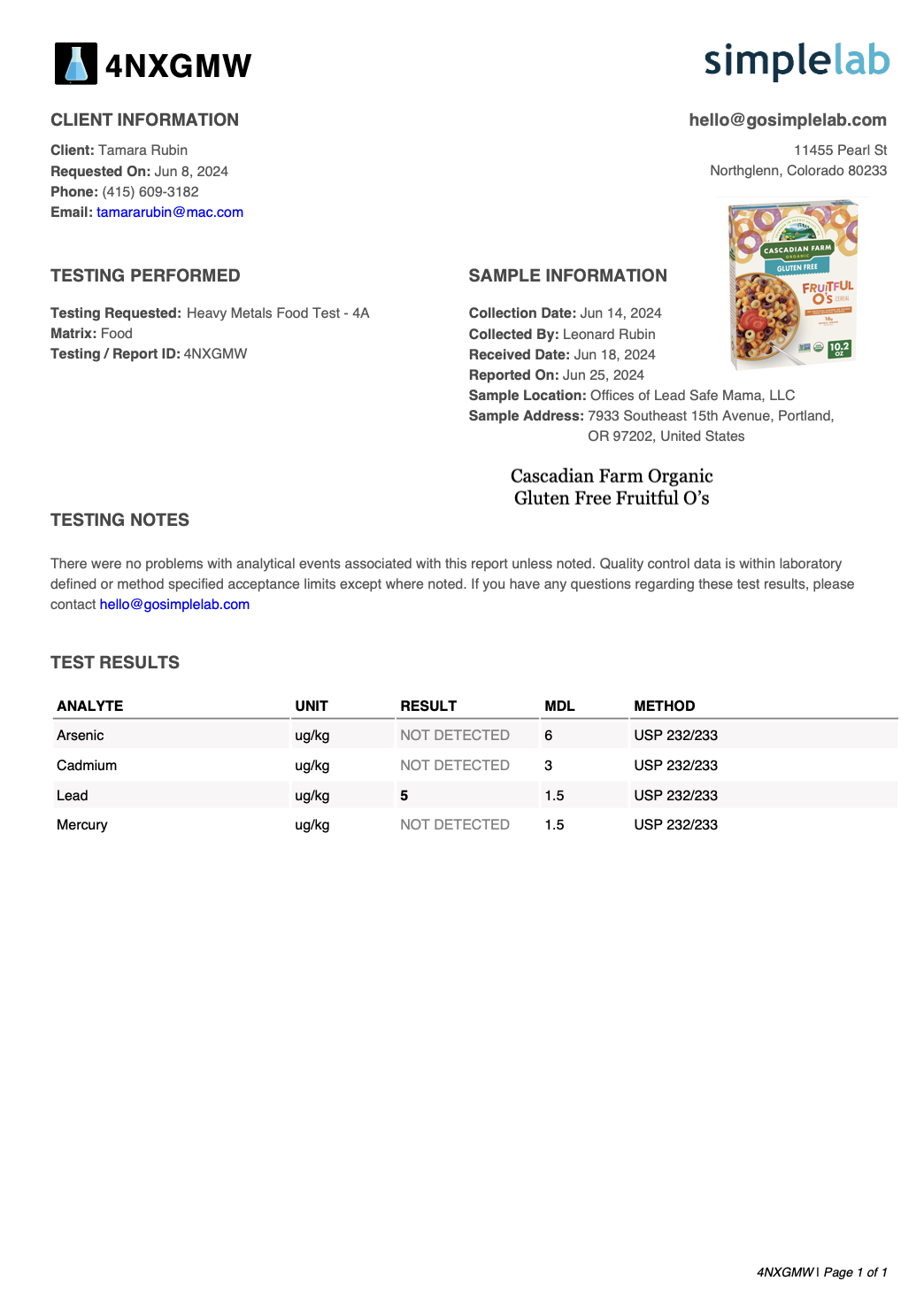Cascadian Farm Organic Gluten Free Fruitful O’s (General Mills) tests positive for Lead. See the laboratory report here.
For those new to the Lead Safe Mama website:
Tamara Rubin is a multiple-federal-award-winning independent advocate for childhood Lead poisoning prevention and consumer goods safety, and a documentary filmmaker. She is also a mother of Lead-poisoned children (two of her four sons were acutely Lead-poisoned in 2005).
- Tamara owns and runs Lead Safe Mama, LLC — a unique community collaborative woman-owned small business for childhood Lead poisoning prevention and consumer goods safety.
- Since July of 2022, the work of Lead Safe Mama, LLC has been responsible for five product recalls (FDA and CPSC).
- All test results reported on this website are science-based, accurate, and replicable.
- Please check out our press page to see some of the amazing coverage of our work so far this year!
Here’s our affiliate link to the test kit Lead Safe Mama, LLC uses for the laboratory food test results we publish: https://amzn.to/3UIPcHP.
This is an ad-free article.
Advertising and affiliate income help Lead Safe Mama, LLC cover the costs of the work we do here (independent consumer goods testing and childhood Lead-poisoning prevention advocacy). We have removed ads from most of our more widely-read articles (and newly published articles, too — like this one!) to make them easier for you to read. In addition to supporting this work by starting any shopping you might be doing with a click on our affiliate links, if you would like to support the independent consumer goods testing and childhood Lead poisoning prevention advocacy work of Lead Safe Mama, LLC by making a contribution (which will also help us keep our more widely-read articles ad-free), click here. Thank you!
Important Background: What is an Action Level?
Please note the following key points.
The original lab report for this product is below (at the bottom of this page).
The graphic above shows the levels of metals detected in this product (in red) along with the low threshold of detection (in green) for each of the metals not detected with the laboratory testing that Lead Safe Mama, LLC had completed for this product. The numbers are juxtaposed to (in blue) the “Action Level” that was proposed by the medical and scientific community in 2021 as part of the Baby Food Safety Act.
- These levels were set as “Action Levels” that are (in fact) protective of human health.
- An “Action Level” is NOT the same as a “Maximum Allowable Level.”
- Once the level of a heavy metal in food reaches the “Action Level,” that metal is officially over the threshold of safe and into the realm of heavy metal levels that can cause lasting harm to children.
- The “Action Level” is the level at which the scientific and medical community believes the company (or government) needs to take ACTION to fix the problem (which also includes taking ACTION to inform the public that a product has an unsafe level of the metal detected at-or-above the “Action Level” — and which relevant batch numbers should be recalled/ not consumed).
- These Action Levels are not arbitrary, however they were not passed into law.
- These Action Levels reflect the current advice of the medical and scientific communities as levels both achievable and also protective of infant and toddler health — regardless of the fact it is not illegal to have food for children test positive at (or above) these levels (as the Baby Food Safety Act of 2021 was not passed into law).
- The legitimacy of these levels as “Action Levels”/ “Levels of Concern” (even though they were not adopted as law) is similar to the legitimacy of the America Academy of Pediatrics’ level of concern for Lead in water — which is 1 ppb — even though the FDA’s official “level of concern” for Lead in water is 15 ppb (you can read more about that here).
For safer food choices for kids, click here.
If you are new here, please check out our website menu (link) to see all the other types of items we test and report on! Welcome to the site!
Published: July 4, 2024
- As you can see, our laboratory test result (below/bottom of this page) for the product pictured came back as positive for FIVE (5) parts per billion (ppb) Lead. It’s shown in this graphic below as well…
- Given the 2021 proposed baby food legislation set an Action Level of 5 ppb Lead, this product actually tested positive for an unsafe level of Lead (within that context).
- Note: While one could cite the “10 ppb” level “for infant and toddler food that is cereal” (in the chart above), it is important to clarify WHY the 5 ppb level really applies in this particular case (instead of the 10 ppb level).
- The 10 ppb “cereal” Action Level specifically was set to take into account the fact that “cereal” is typically consumed with milk.
- In that circumstance, the milk (being a liquid) should (theoretically) have lower Lead levels – lower than 5 ppb (and hopefully closer to 1 ppb or lower) and in that scenario, mixing the cereal with milk will lower the overall level of the food to below 5 ppb Lead.
- That was the logic for proposing setting the Lead Action Level for “food that is cereal” at 10 ppb.
- However, as any parent of an infant or toddler knows, this type of cereal (formed/ shaped into small Os to make them easy for children to hold and put into their own mouth) is more-often-than-not used as a snack food for infants and toddlers rather than always served as a “bowl of cereal” diluted with milk.
- What parent has not filled a to-go cup or baggie with “cheerios” (or some alternative similar product) to take with them to the park (or on a car-ride) as an easy snack!?
- It is for this reason the Action Level for this specific sort of food, products sold as cereals but just as often consumed “straight” (i.e. undiluted — as snack foods), should have been set at 5 ppb Lead.
- Unfortunately, in any case, the Baby Food Safety Act of 2021, which included the above noted recommendations made by the scientific and medical community, was not passed into law. In fact, there is currently NO legislatively mandated federal standard for safety for food across the board (as measured in ppb) that is truly protective of human health — let alone one that protects the health of infants and toddlers (who eat all foods — not just baby foods).
Takeaway
This cereal has enough Lead in it that, were it to be categorized not as a “cereal” expected to be normally served/ diluted with milk but rather as it is commonly used, a snack food consumed by infants and toddlers, it would test positive for Lead at the proposed 2021 Action Level.
While it may seem harsh (extreme, or exaggerated in some way) to call this product out as having an “unsafe level of Lead” given it just hits the Action Level, it is important to understand the term “Action Level” as detailed above (the level at which the scientific community has determined action needs to be taken to fix the problem).
It is also important to note that concerns for the presence of heavy metals in foods based on “serving sizes” are not relevant, as it is quite rare for any child (or any person) to consistently only eat a “serving size” worth of any particular food. Children — even younger children — often eat more than a single “serving size” in a sitting! You can read more about those concerns at this link.
Using an Action Level measured in parts per billion/ppb (as the basis to determine the safety of any particular food) is a much better standard than using the potential amount of a toxicant that may be ingested if a child eats only the “serving size” as dictated/ determined by the manufacturer. This is especially the case with Lead, which is a known neurotoxin that all federal agencies agree is unsafe for children at ANY LEVEL (so serving size should not matter in any case).
If you have been feeding this to your young children, my recommendation is you may want to stop doing that immediately and consider getting them a blood Lead test if they have not been tested recently. While it is unlikely (but not impossible) that ingesting this particular food on a regular basis might lead to an elevated blood Lead Level (BLL), it is still useful to get a baseline BLL test — which will also help determine if your child has had any Lead exposure (regardless of the potential source of that exposure). You can learn more about BLL testing at this link, and this link.
Some additional reading & links that may be of interest:
- A link with a spreadsheet showing all of our food testing currently in progress (since June 2024).
- The Lead Safe Mama affiliate link to purchase the test kits we used for this testing.
- Our landing page with links to all the results for food products we have tested.
- Here’s how to send your own food samples into a lab for testing (the cost is $195 per single food sample tested for Lead, Cadmium, Mercury, and Arsenic) or how to collaborate with Lead Safe Mama, LLC on the food testing we’re hosting.
- The Food category of articles here on Lead Safe Mama dot com.
Amazon links are affiliate links. If you purchase something after clicking a Lead Safe Mama, LLC Amazon affiliate link, we may receive a percentage of what you spend at no extra cost to you.
Never Miss an Important Article Again!
Join our Email List











How could lead have gotten into this product? We eat this cereal brand once a week, thinking it was the least worst cereal, and I have a bulk amount from sales. 🙁
Likely from the manufacturing equipment. Note: It is not illegal for this product to have Lead (there are no relevant current laws – hopefully that is clear from the article).